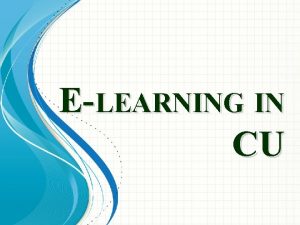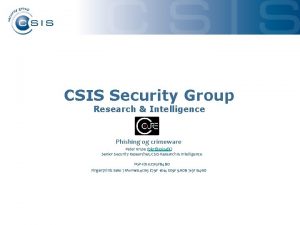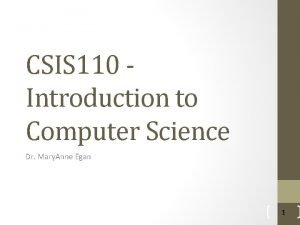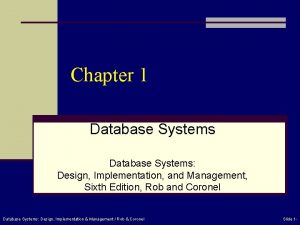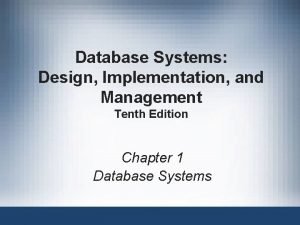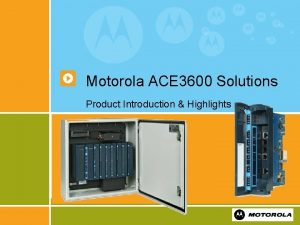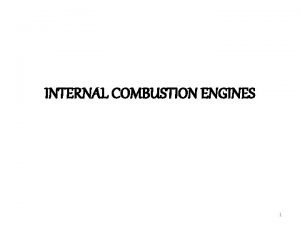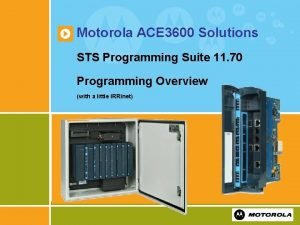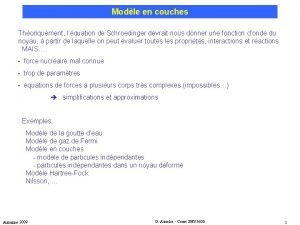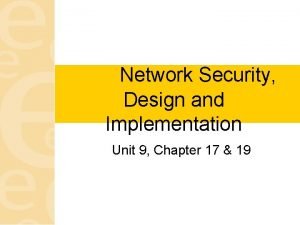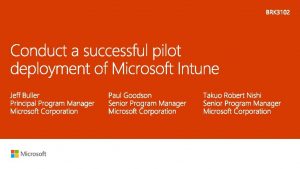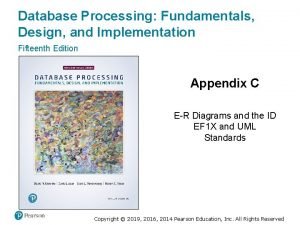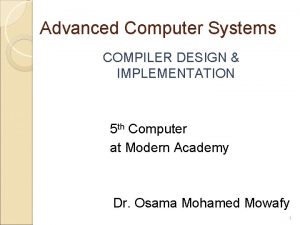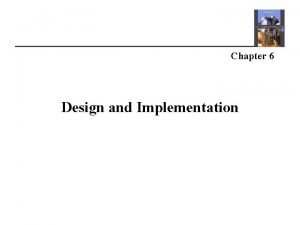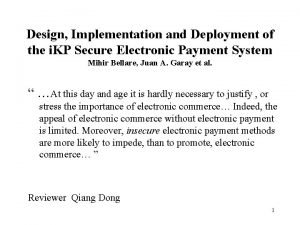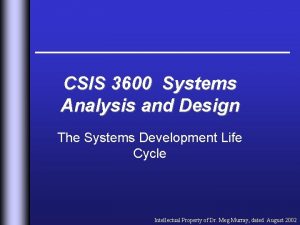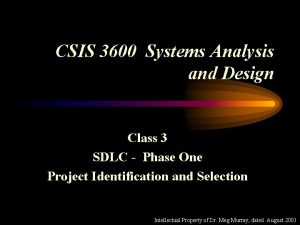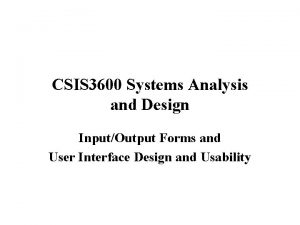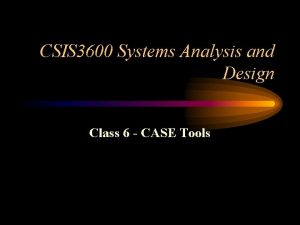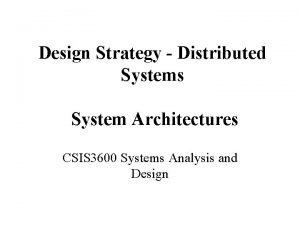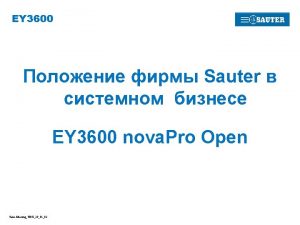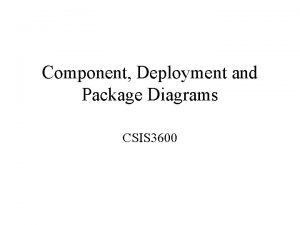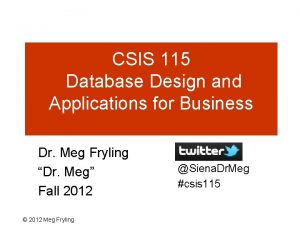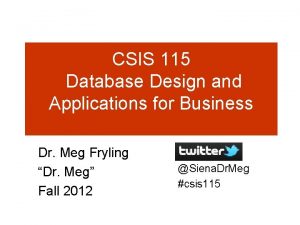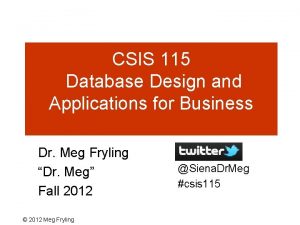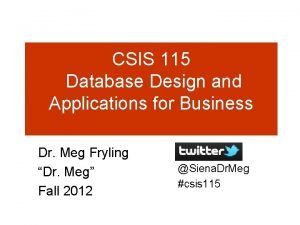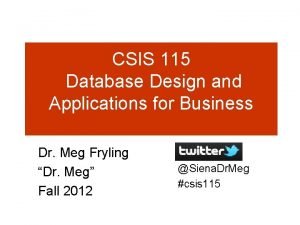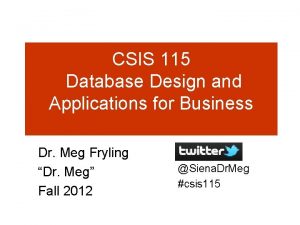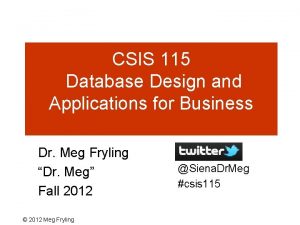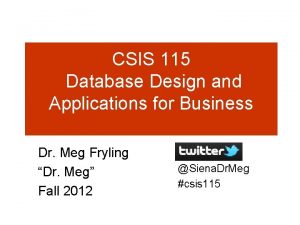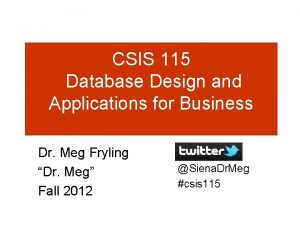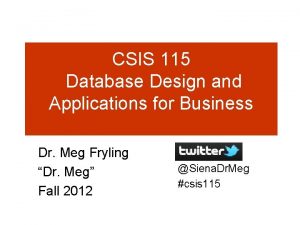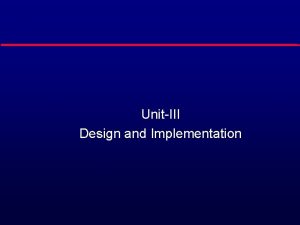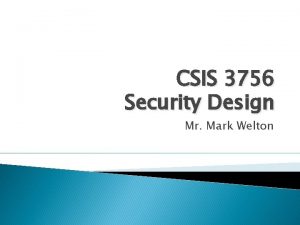CSIS 3600 Systems Analysis and Design Systems Implementation




































- Slides: 36

CSIS 3600 Systems Analysis and Design Systems Implementation: Installation

Implementation Phase • After maintenance and continuing support, the implementation phase of the systems development life cycle is the most resource intensive and timeconsuming phase of the entire life cycle. • It is resource intensive because so many people are involved in the process. • Implementing a new information system into an organizational context is shaped and reshaped by the people who work in the organization.

Major Activities Six major activities of System Implementation: – Coding – Testing – Installation – Documentation – Training – Support

Coding • Coding is the process whereby the physical design specifications are turned into working computer code.

Coding in Teams • A team of programmers normally works on program development. • Using multiple programmers compresses the development schedule by allowing many portions of the system to be developed simultaneously. • Component architectures are supported well by a team approach to programming

Issues in Using Teams • Organization of the team • Task assignment to specific teams or members • Member and team communication and coordination

Team Type Collaborating Peers Characteristics Equal Skill Level Overlapping specialties Consensus-based Project Type • Experimentation • Creative problem solving Chief Developer • Organized as a military platoon or squad • One leader makes all important decisions • Well-defined objectives • Well-defined path to completion Collaborative Specialist • Wide variation in skill and experience • Minimal overlapping technical specialties • Leader is primarily an administrator • Consensus–based • Diagnosis or experimentation • Creative and integrative problem solving • Wide range of technology

Moving to a New System • Transitioning to new systems involves managing change from pre-existing norms and habits. • Change management involves: – Unfreezing -- loosening up peoples’ habits and norms – Moving -- transition from old to new systems – Refreezing -- institutionalize and make efficient the new way of doing things Power. Point Presentation for Dennis, Wixom & Tegarden Systems Analysis and Design Copyright 2001 © John Wiley & Sons, Inc. All rights reserved.

Implementing Change Power. Point Presentation for Dennis, Wixom & Tegarden Systems Analysis and Design Copyright 2001 © John Wiley & Sons, Inc. All rights reserved.

Migration Planning • What activities will be performed when and by whom – Technical aspects • Installing hardware and software • Converting data – Organizational aspects • Training users on the system • Motivating employees to use the new system to aid in their work Power. Point Presentation for Dennis, Wixom & Tegarden Systems Analysis and Design Copyright 2001 © John Wiley & Sons, Inc. All rights reserved.

Elements of a Migration Plan Power. Point Presentation for Dennis, Wixom & Tegarden Systems Analysis and Design Copyright 2001 © John Wiley & Sons, Inc. All rights reserved.

Installation or Conversion • Installation is the stage where the system is moved into production. • It can be a very difficult stage. • There is much documentation about system implementation failures. • Installation often means replacing an existing system be it another computer system or a manual system • Implementation as an organizational change process is not always successful.

Factors of Success Factors contributing to successful implementation of a computer system – management support of the system, – involvement of the users in the development of the system, – organizational commitment to change, – strong leadership, – system characteristics such as ease of use – users perception of how the system helps them do their work

Factors for Success • On the other hand, research has also shown that even when these factors exist, system implementations sometimes fail. • So while these factors may help, there are no sure recipes you can follow to guarantee success.

Approaches to Conversion The four basic approaches to installation, the one chosen will depend on: – the current organizational environment, – the scope of the project, – the complexity of the change that the new system represents – and the organization's risk aversion.

Key Factors in Selecting a Conversion Strategy • Risk – Seriousness of consequences of remaining bugs • Cost – Parallel requires paying for two systems for a period of time – Simultaneous requires more staff to support all locations • Time – Parallel, phased, and modular require more time Power. Point Presentation for Dennis, Wixom & Tegarden Systems Analysis and Design Copyright 2001 © John Wiley & Sons, Inc. All rights reserved.

Conversion Styles • Direct conversion – The new system instantly replaces the old • Parallel conversion – For a time both old and new systems are used. The old is abandoned when the new is proven fully capable Power. Point Presentation for Dennis, Wixom & Tegarden Systems Analysis and Design Copyright 2001 © John Wiley & Sons, Inc. All rights reserved.

Conversion Location • Pilot conversion – One or more locations are converted to work out bugs before extending to other locations • Phased conversion – Locations are converted in sets • Simultaneous conversion – All locations are converted at the same time Power. Point Presentation for Dennis, Wixom & Tegarden Systems Analysis and Design Copyright 2001 © John Wiley & Sons, Inc. All rights reserved.

Conversion Modules • Whole system conversion – All modules converted in one step • Modular conversion – When modules are loosely associated, they can be converted one at a time Power. Point Presentation for Dennis, Wixom & Tegarden Systems Analysis and Design Copyright 2001 © John Wiley & Sons, Inc. All rights reserved.

Direct Conversion • The old system is 'turned off' and replaced by the new system, all at one time • Sometimes called the 'cold turkey' approach • It can be very risky because the abruptness of the change may not be well received. • On the other hand, it is usually the least costly approach and in some cases, where the old system cannot co-exist with the new system, the only plausible approach available.

Parallel Conversion • This is the least risky approach. • The old system is left in place and the new system turned on. • Both systems are running alongside each other until end users feel comfortable and confident with the new system. • The main problem with this approach is the cost of running dual systems and ensuring the stay in sync. • It is not usually practical with large systems.

Single Location (Pilot) Conversion • Often referred to as the 'pilot approach. ' • Rather than converting the entire organization, a single location is selected and the current system in replaced with the new system at that location • The key advantage is that it limits potential damage and potential cost by providing the opportunity to assess the impact of the new system. • The primary roadblock is when data must be shared between systems as extra programs would be required to keep the data in sync.

Phased Conversion • The new system is brought on-line in functional components; different parts of the old and new systems are used in cooperation until the whole new system is installed. • The benefit, just like that for single location installation, is reduced exposure to risk. • The main drawbacks are extra focus on insuring synchronization and a long period of time for complete installation. • Not workable when the old system and new system are completely incompatible.

Simultaneous Conversion • All sites are converted at the same time

CHANGE MANAGEMENT Power. Point Presentation for Dennis, Wixom & Tegarden Systems Analysis and Design Copyright 2001 © John Wiley & Sons, Inc. All rights reserved.

Key Roles in Change Management • The sponsor is the business person who initiated the request for the new system • The change agent is the person(s) who lead the change effort • The potential adopter(s) are the people who must change. Power. Point Presentation for Dennis, Wixom & Tegarden Systems Analysis and Design Copyright 2001 © John Wiley & Sons, Inc. All rights reserved.

Understanding Resistance to Change • What is good for the organization, is not necessarily good for the individuals who work there • Cost versus benefit of transition as well as of to-be system • Adapting to new work processes requires effort, for which there may be no additional compensation Power. Point Presentation for Dennis, Wixom & Tegarden Systems Analysis and Design Copyright 2001 © John Wiley & Sons, Inc. All rights reserved.

Costs and Benefits of Change Power. Point Presentation for Dennis, Wixom & Tegarden Systems Analysis and Design Copyright 2001 © John Wiley & Sons, Inc. All rights reserved.

Revising Management Policies • No computer system will be successfully adopted unless management policies support its adoption • Management tools for supporting adoption – Standard operating procedures (SOPs) – Measurements and rewards – Resource allocation Power. Point Presentation for Dennis, Wixom & Tegarden Systems Analysis and Design Copyright 2001 © John Wiley & Sons, Inc. All rights reserved.

Motivating Adoption • The information strategy aims to convince adopters that change is better • The political strategy uses organizational power to motivate change • Differentiate between ready adopters, reluctant adopters, and resistant adopters Power. Point Presentation for Dennis, Wixom & Tegarden Systems Analysis and Design Copyright 2001 © John Wiley & Sons, Inc. All rights reserved.

Training • Every new system requires new skills • New skills may involve use of the technology itself • New skills may be needed to handle the changed business processes Power. Point Presentation for Dennis, Wixom & Tegarden Systems Analysis and Design Copyright 2001 © John Wiley & Sons, Inc. All rights reserved.

Training and User Documentation • Training and user documentation are important factors that contribute to the success of system implementation and use. • It is through training and user documentation that users gain exposure to the system. System implementation plans must account for how training and user documentation will be developed and delivered to the end user. Power. Point Presentation for Dennis, Wixom & Tegarden Systems Analysis and Design Copyright 2001 © John Wiley & Sons, Inc. All rights reserved.

What to Train • Should focus on helping users accomplish their tasks • Use cases provide an outline for common activities and a basis to plan training Power. Point Presentation for Dennis, Wixom & Tegarden Systems Analysis and Design Copyright 2001 © John Wiley & Sons, Inc. All rights reserved.

Types of Training • • • Use of the system General computer concepts Information system concepts Organizational concepts System management System installation

Methods of Training • Tutorial – one person taught at a time • Course – several people taught at a time (instructor lead) • Computer- aided – CBT, etc. • Interactive Training Manuals – combination of tutorial and course • Resident Expert • Software help components • External sources – such as vendors

Project Failure If you want to investigate examples of project failure, visit: • http: //www. scit. wlv. ac. uk/~cm 1995/cbr quest. html
 Cu open moodle
Cu open moodle Csis secure dns
Csis secure dns Csis 110
Csis 110 Database system design implementation and management
Database system design implementation and management Database systems design implementation and management
Database systems design implementation and management 8-1 practice geometric mean
8-1 practice geometric mean Ace 3600
Ace 3600 Yuöe
Yuöe Brake power formula
Brake power formula Sts application download
Sts application download 3600/23
3600/23 Echo bear cat generator
Echo bear cat generator майл
майл 110000/3600
110000/3600 Kendall & kendall systems analysis and design
Kendall & kendall systems analysis and design Input and output reports and analysis
Input and output reports and analysis Network security design and implementation
Network security design and implementation Uiecu hours
Uiecu hours Cobit 2019 foundation exam questions
Cobit 2019 foundation exam questions Accessible learning experience design and implementation
Accessible learning experience design and implementation Intune deployment project plan
Intune deployment project plan Fundamentals of design
Fundamentals of design Channel design and implementation
Channel design and implementation Advanced compiler design and implementation
Advanced compiler design and implementation Design and implementation issues of dsm
Design and implementation issues of dsm Obiarchitecture
Obiarchitecture In design and implementation, reuse levels are:
In design and implementation, reuse levels are: System implementation and operation
System implementation and operation I kp
I kp Systems analysis & design in an age of options pdf
Systems analysis & design in an age of options pdf System analysis
System analysis Systems analysis and design in a changing world
Systems analysis and design in a changing world Systems analysis and design in a changing world
Systems analysis and design in a changing world System analysis and design alan dennis
System analysis and design alan dennis Introduction of system analysis and design
Introduction of system analysis and design Ssadm model
Ssadm model A modern approach to systems analysis and design
A modern approach to systems analysis and design
